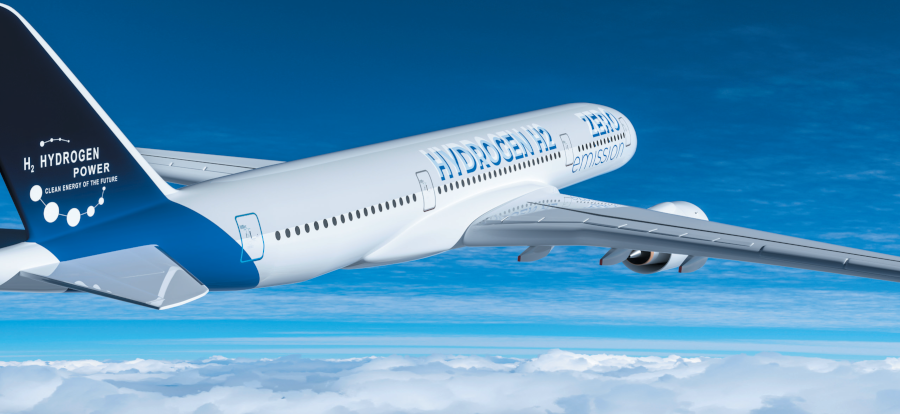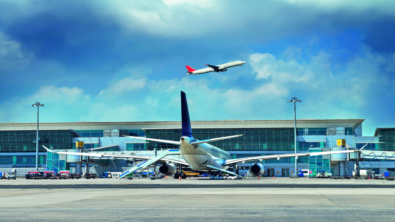Sustainable aviation fuels

Earth and those beings who populate its surface are experiencing unprecedented levels of climate change. The current temperature is already 1.1 degrees Celsius higher than it was prior to the Industrial Revolution.i If we don’t act now to keep global warming below 1.5 degrees Celsius, climate and weather extremes will continue to deviate from what we now consider “normal,” causing significant disruption and damage to our ecosystem and, in turn, our food supply, economy, health and happiness.
Of all human activities, burning fossil fuels contributes to climate change more than any other, and the aviation industry is a major contributor to greenhouse gas (GHG) emissions – 4.9 percent to be exact. Even though it might seem insignificant, 1.9 billion tons of carbon dioxide is nonetheless emitted annually.
It is predicted that air travel will increase threefold by 2050. Unless we discover carbon-neutral methods of propulsion, GHG emissions will continue to threaten our planet. To ensure that the aviation industry complies with the carbon neutrality goals put forth in the Paris Agreement, the entire industry must undergo a tremendous transformation to accommodate alternative energy sources like hybrid-electric, synthetic fuels and hydrogen.
Out with the old fuel: Kerosene
The fuel used in modern aircraft is a refined kerosene-based liquid formulated to make it ideal for aviation. With an energy density of -40 megajoules per kilogram (MJ/kg), it has a low freezing point, which allows for use at higher altitudes; is extremely combustible, which powers takeoff; and has a lower viscosity, which will not clog engines.
But, just like any other fossil fuel, the kerosene used in aviation, when burned, consumes oxygen while adding carbon dioxide, sulfur dioxide, nitrogen dioxide, carbon monoxide, black carbon and water vapor to the atmosphere.
As climate change worsens, it is becoming evident that the aviation industry requires sustainable alternatives, as well as a comprehensive solution to remain competitive in an innovative, conscientious market.
What are sustainable fuels for aviation?
Hybrid-electric for smaller, regional aircraft
Regional flights are more prevalent than one might think. They account for 40 percent of flights and 36 percent of flight hours. In addition, 36 percent of airports only cater to smaller aircraft like single-engine prop planes, which explains why hybrid-electric propulsion used in prop planes is a promising stepping-stone in the quest for groundbreaking technologies and zero emissions by 2050.
Fully electric aircraft have great promise for improving local air quality; no pollutants are released because combustion is prevented. Plus, due to the absence of combustion and other sources of noise in an aircraft, electric propulsion is quieter. This deals with another form of pollution, noise.
Although they are becoming more fuel-efficient, airplanes generally get bigger and heavier as they carry more people, requiring more fuel and detracting from real fuel efficiency. Batteries alone are too heavy, but hybrid-electric may be a partial, short-term solution.
Synthetic fuels for short-to-medium-range aircraft
A drop-in fuel is an alternative fuel that combines elements from H2O and CO2 and can be used “as is” in lieu of specific conventional (usually petroleum-derived) fuels with no modifications needed to the engines or fuel systems. However, for a synthetic fuel to be utilized in existing kerosene systems and aircraft sans any additional technological adaptations, fossil fuel-based kerosene must be mixed with the synthetic kerosene.
Hydrogen for large aircraft
Hydrogen is one technique that is receiving special attention. Because of its high energy density, it is advantageous for large-scale aircraft and the expanding commercial aviation industry. It has benefits that extend beyond rival sustainable propulsion methods. Unlike batteries and sustainable fuels, hydrogen is both lightweight and powerful (120 MJ/kgs per unit of mass). The output is water.
The power of hydrogen can be harnessed in different ways: hydrogen-powered gas turbines, hydrogen fuel cells and/or hybrid systems that marry the two. Check out this white paper to learn more about hydrogen-powered aircraft design.
Disadvantages of sustainable aviation fuel
There are specific arguments against using sustainable propulsion methods in aviation, and they vary based on the type, size and range of an aircraft. These difficulties fall under two general categories: The rate of innovation and expense.
Glaring disadvantages in hybrid-electric propulsion may outweigh any positives, and they all come down to one component—the battery. Batteries are heavy and have a low energy density – 10 to 15 kW/kg. The excessive weight and weakness mean that, at its current level of innovation, fully electric/battery-powered propulsion is only operational in smaller, regional aircraft. The weight and number of needed batteries would ground a larger aircraft.
Hybrid-electric is a feasible alternative in the meantime. It lightens aircraft and lessens emissions, but it is not entirely free of releasing GHG into the atmosphere.
While synthetic fuels are free of impurities like sulfur, they nevertheless expel carbon into the surrounding environment. Drop-in fuels are mixed with traditional fossil-fuel kerosene and may have reduced emissions, but there are still GHG emissions. Non-drop-in fuels, like certain organic biofuels, require extensive modification to aircraft.
The third option is hydrogen. With its relative complexity and inefficiency, its production process is expensive. Whether hydrogen is kept as a gas or a liquid, significant design changes to the aircraft will be necessary. Hydrogen is extremely flammable and burns significantly hotter and faster than kerosene, so the aviation industry will need to account for and design larger, highly pressurized and temperature-controlled storage. The body of the plane will likely store hydrogen. This, in turn, affects the layout of the rest of the plane as engineers now struggle with where to locate passengers and cargo.
From a lifecycle viewpoint, each fuel alternative has the potential to significantly reduce the greenhouse gas emissions of commercial aviation. While alcohols and gases are taken into consideration, they are restricted by aircraft modifications or the creation of new aircraft types, whereas other kerosene-like fuel choices are mostly hindered by a lack of production capacity.
With the added complexities and expense, a digital transformation of processes is crucial.
Siemens Simcenter and the digital twin
Siemens has a variety of cutting-edge engineering simulation and testing solutions that are intended to improve the design, development and sustainability of aviation.
Simcenter, part of the Siemens Xcelerator portfolio, can accelerate project timelines, assist in cost management and aid the certification process through its efficiency, comprehensive management and simulation. Simulation using a digital twin optimizes design decisions and reduces the reliance on costly, time-consuming physical prototypes.
A digital transformation that includes Simcenter means digitalization can assist engineers in creating safe hydrogen-powered aircraft that satisfy sustainability objectives.
Working toward a future of sustainable aviation
We are already experiencing higher sea levels, stronger and more frequent storms, long-lasting heat waves, extreme drought, prolonged wildfire seasons and altered precipitation patterns. Alternate power sources are not just possibilities; they are necessities if we want to mitigate the effects of climate change.
But since these new propulsion systems will need different forms of storage, they will necessitate entirely new airplane designs. In addition, to meet new structural aircraft layouts and refueling needs, such as electric charging stations for hybrid-electric aircraft, airport terminals and facilities will need to be renovated. None of this will be cheap or simple as it constitutes an almost total overhaul of the aviation industry.
Interested? Watch the video to learn more.


